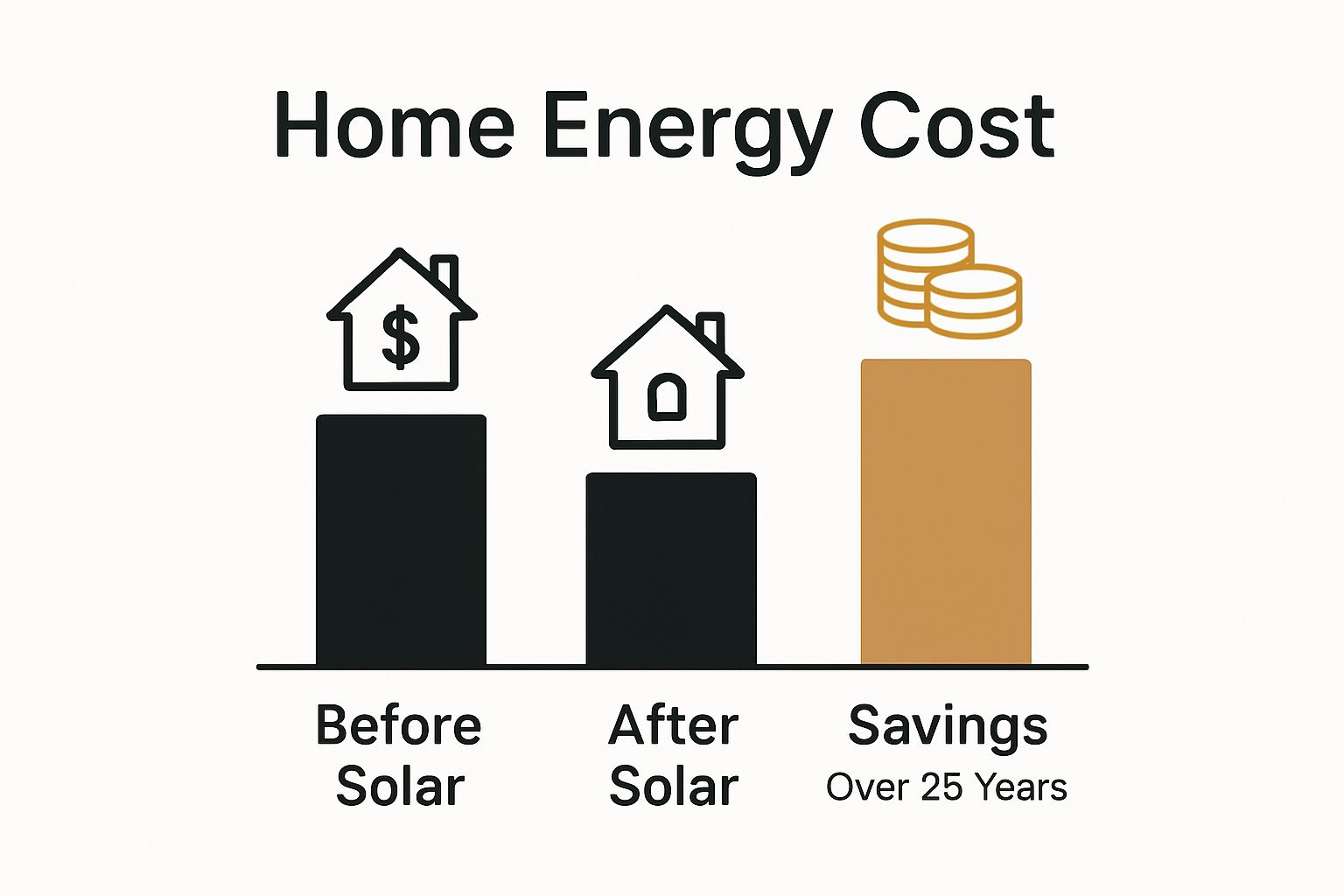
Solar energy promises a cleaner way to power everything from homes to entire cities. And the numbers are catching people off guard. Modern solar panels now reach conversion rates between 15% and 22%, and some households cut up to 100% off their electricity costs. Most think switching to solar is complicated or only makes sense in sunny places. The reality is, solar technology is simpler, smarter, and more rewarding than most ever imagined.
Table of Contents
- What Is Solar Energy And How Does It Work?
- Why Solar Savings Matter For Consumers And The Environment
- Key Financial Benefits Of Solar Energy Adoption
- Understanding Solar Incentives And Tax Credits
- Real-World Case Studies Of Solar Savings Success
Quick Summary
| Takeaway | Explanation |
|---|---|
| Solar energy reduces utility bills significantly. | Homeowners can save between 70% to 100% on electricity costs based on their solar system size and local rates. |
| Tax incentives lower solar installation costs. | Federal and state tax credits can offset up to 30% of solar installation expenses, making solar more affordable. |
| Solar systems contribute to climate change mitigation. | Generating clean energy helps reduce carbon emissions, offsetting about 3 to 4 tons annually for a single home. |
| Solar installations increase property value. | Homes with solar technology can see an increase in market value, offering financial benefits on resale. |
| Different financing options enhance solar adoption. | Options like net metering and performance-based incentives allow homeowners to maximize savings from their solar investments. |
What is Solar Energy and How Does it Work?
Solar energy represents an incredible renewable power source that harnesses the sun’s radiant light and heat to generate electricity and thermal energy. At its core, solar technology transforms sunlight into usable power through sophisticated mechanisms that are both elegant and efficient. Our comprehensive guide on solar cell technology provides deeper insights into this fascinating process.
The Science Behind Solar Power Conversion
The fundamental mechanism of solar energy relies on photovoltaic (PV) cells, which are ingeniously designed semiconductor devices typically composed of silicon. When sunlight strikes these cells, it triggers a remarkable quantum phenomenon where photons interact with electrons, causing them to become energized and generate an electric current. According to research from the U.S. Department of Energy, this process allows solar panels to directly convert sunlight into electricity without any moving parts or combustion.
Key components of solar energy systems include:
- Photovoltaic Cells: The primary units that convert sunlight into electrical energy
- Inverters: Equipment that transforms direct current (DC) into alternating current (AC) for home and grid use
- Solar Panels: Assemblies of multiple PV cells working together to maximize energy generation
Practical Applications and Energy Transformation
Solar energy’s versatility extends far beyond residential rooftop installations. Modern solar technologies can generate power for entire communities, industrial complexes, and even contribute to national electrical grids. The conversion process involves capturing solar radiation and transforming it through two primary methods: photovoltaic conversion, which directly produces electricity, and solar thermal technology, which uses sunlight to generate heat for various applications.
The efficiency of solar energy systems continues to improve, with contemporary solar panels achieving conversion rates between 15% to 22%, representing a significant technological advancement in renewable energy production. This ongoing innovation promises increasingly sustainable and accessible clean energy solutions for global power needs.
Below is a table summarizing the main components of a typical solar energy system and their functions, helping readers quickly grasp the building blocks of solar technology.
| Component | Description |
|---|---|
| Photovoltaic Cells | Convert sunlight into electrical energy |
| Inverters | Transform DC electricity into AC for grid/home use |
| Solar Panels | Assemblies of PV cells maximizing energy generation |
| Net Metering System | Enables utility credit for excess energy supplied |
| Mounting Structure | Supports panels for optimal sun exposure |
Why Solar Savings Matter for Consumers and the Environment
Solar energy represents more than a technological breakthrough. It is a powerful economic and environmental solution that delivers substantial benefits to both individual consumers and broader societal systems. Understanding the solar benefits reveals a comprehensive perspective on this transformative energy approach.
Economic Impact for Individual Households
The financial advantages of solar energy extend far beyond simple utility bill reductions. Homeowners who invest in solar technology can experience significant long term economic gains.
VIDEO:video_content] According to [research from the National Renewable Energy Laboratory, residential solar installations can reduce electricity costs by 70% to 100%, depending on system size and local energy rates.
Key economic benefits include:
- Reduced Monthly Energy Expenses: Immediate decrease in utility bill costs
- Increased Property Value: Solar installations can boost home market prices
- Long Term Financial Investment: Potential for energy credit earnings and tax incentives
Environmental Sustainability and Climate Mitigation
Beyond personal financial considerations, solar energy plays a critical role in environmental preservation. By generating clean electricity without greenhouse gas emissions, solar technology directly contributes to climate change mitigation strategies. A single residential solar system can offset approximately 3 to 4 tons of carbon emissions annually, equivalent to planting over 100 trees each year.
The environmental impact of widespread solar adoption is profound. Transitioning from fossil fuel dependence to renewable energy sources represents a crucial strategy in reducing global carbon footprints and combating climate change. This shift not only preserves natural ecosystems but also promotes a sustainable energy infrastructure for future generations.
Key Financial Benefits of Solar Energy Adoption
Transitioning to solar energy is not just an environmentally conscious decision, but a strategic financial investment that offers substantial economic advantages for homeowners and businesses. Understanding the rooftop solar tax credit can unlock significant monetary benefits that extend well beyond traditional energy investments.
Immediate and Long Term Cost Savings
Solar energy provides a powerful mechanism for reducing ongoing energy expenditures. According to research from the Lawrence Berkeley National Laboratory, residential solar installations can generate substantial financial returns through multiple channels. Homeowners typically experience an average reduction of 70% in monthly electricity costs, with potential savings accumulating to tens of thousands of dollars over the system’s lifetime.
Key immediate financial advantages include:

- Reduced Monthly Energy Expenses: Dramatic decrease in utility bill costs
- Fixed Energy Pricing: Protection against future electricity rate fluctuations
- Predictable Financial Planning: Stable energy costs for 25+ years
Tax Incentives and Financial Mechanisms
Government policies have created robust financial frameworks that make solar investments even more attractive. Federal and state tax credits can offset up to 30% of solar installation costs, significantly lowering initial investment requirements. Additionally, many regions offer net metering programs, allowing homeowners to earn credits for excess electricity generated and fed back into the power grid.
The financial landscape of solar energy continues to evolve, with technological improvements and policy support making solar investments increasingly accessible and economically compelling. By strategically leveraging available incentives and understanding the long term financial trajectory, consumers can transform solar energy from an environmental choice into a smart economic strategy.
Understanding Solar Incentives and Tax Credits
Solar incentives and tax credits represent critical financial mechanisms that dramatically reduce the economic barriers to renewable energy adoption. Exploring the commercial solar tax credit reveals the intricate strategies governments use to encourage sustainable energy investments.
Federal and State Level Solar Incentives
The landscape of solar financial support is complex and multifaceted. According to research from the Database of State Incentives for Renewables and Efficiency, solar incentive programs vary significantly across different jurisdictions. The federal government currently offers a substantial Investment Tax Credit (ITC) that allows homeowners and businesses to deduct a percentage of their solar installation costs directly from their federal tax liability.
Key components of solar financial incentives include:
- Federal Investment Tax Credit: Direct reduction of tax liability for solar investments
- State Level Rebates: Additional financial support varying by region
- Performance Based Incentives: Payments based on actual electricity generated
Navigating Complex Incentive Structures
Understanding the nuanced world of solar incentives requires careful research and strategic planning. Different incentive programs have specific eligibility requirements, application processes, and potential time limitations. Residential solar installations typically qualify for more straightforward incentives, while commercial projects may involve more complex financial calculations.
The financial landscape of solar incentives continues to evolve, with policy changes and technological advancements creating new opportunities for consumers. By staying informed and consulting with solar energy professionals, individuals and businesses can maximize their potential savings and contribute to a more sustainable energy future.
The following table presents a comparison of the major types of solar incentives available, making it easier to understand the distinctions and benefits of each incentive type.
| Incentive Type | Who Qualifies | Key Benefit |
|---|---|---|
| Federal Investment Tax Credit | Homeowners & Businesses | Reduces solar installation cost by up to 30% |
| State Level Rebates | Varies by state | Additional financial support, reduces net cost |
| Performance Based Incentives | Solar system owners | Payments based on electricity generated |
| Net Metering | Participating homeowners | Credits for excess electricity sent to the grid |
Real-World Case Studies of Solar Savings Success
Real-world experiences demonstrate the transformative potential of solar energy investments, providing concrete evidence of substantial financial and environmental benefits. How much solar panels can save you reveals the tangible impact these systems have on individual households and communities.
Residential Solar Success Stories
Homeowners across different regions have documented remarkable financial outcomes from solar installations. According to research from the National Renewable Energy Laboratory, residential solar adopters consistently report significant utility bill reductions and long term economic advantages. In Arizona, a typical single family home with a 6 kilowatt solar system can save approximately $1,200 annually, translating to over $30,000 in energy costs over the system’s 25 year lifespan.
Key characteristics of successful residential solar implementations include:
- Geographic Location Optimization: Strategic panel placement maximizing solar exposure
- System Size Matching: Tailoring installation to household energy consumption
- Net Metering Participation: Leveraging utility credit programs
Commercial and Community Solar Achievements
Beyond individual homes, larger solar projects demonstrate even more impressive economic transformations. Schools, municipal buildings, and commercial enterprises have successfully implemented solar strategies that dramatically reduce operational expenses. A mid sized office building in California reported cutting electricity costs by 75% after installing a comprehensive solar array, showcasing the scalable potential of renewable energy investments.
These case studies underscore a critical insight: solar savings are not theoretical concepts but practical, measurable financial strategies. By carefully analyzing energy needs, understanding local incentives, and designing customized solar solutions, consumers can achieve significant economic and environmental benefits.

Take Control of Your Solar Savings Journey
Feeling lost when it comes to making real savings with solar energy? The article you just read reveals the challenges many face: rising electric bills, complex incentive programs, and uncertainty over which solutions really work. Finding reliable ways to maximize solar savings can feel overwhelming if you do not have the right guidance. That is where we step in. Our dedicated Tips And Techniques section is here to make these complex topics simple and show you actionable steps to lower your energy costs effectively.

Ready to turn understanding into results? Visit HTEXS for expert tips, honest product reviews, and clear how-to guides on solar technology and smart savings. Take charge of your solar journey today, and do not miss out on new insights that could save you money now.
Frequently Asked Questions
What is solar energy, and how does it work?
Solar energy is a renewable power source that converts sunlight into electricity and thermal energy through photovoltaic (PV) cells, which are semiconductor devices that generate an electric current when exposed to sunlight.
What are the main benefits of adopting solar energy for homeowners?
Homeowners can enjoy reduced monthly energy costs, increased property value, and potential tax incentives by investing in solar technology, leading to significant long-term financial gains.
How much can I save on my energy bills with solar panels?
Depending on system size and local energy rates, homeowners can reduce their electricity costs by 70% to 100%, which can translate to thousands of dollars in savings over the lifespan of the solar system.
What types of financial incentives are available for solar energy?
Federal tax credits, state rebates, and performance-based incentives are critical financial mechanisms that can significantly offset solar installation costs, making renewable energy investments more accessible and economical.






